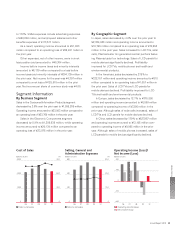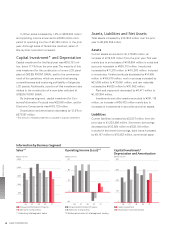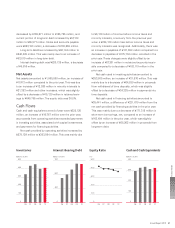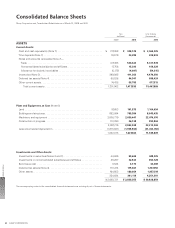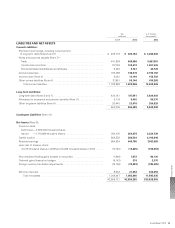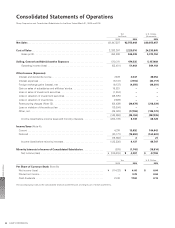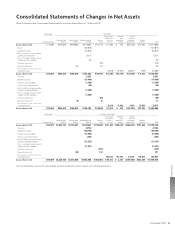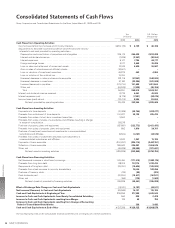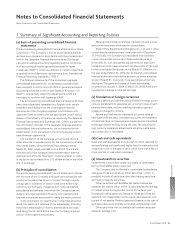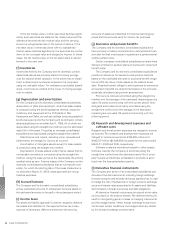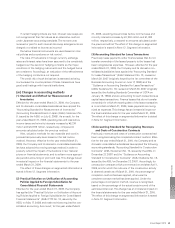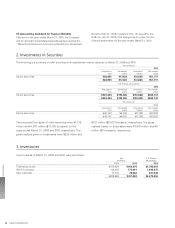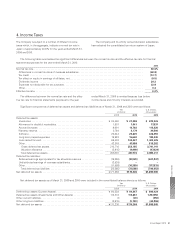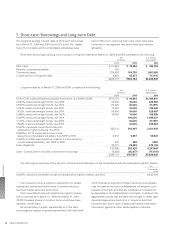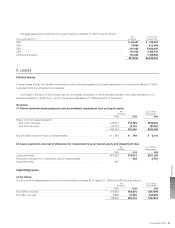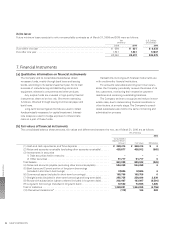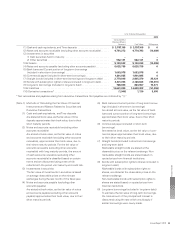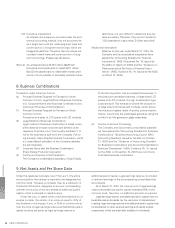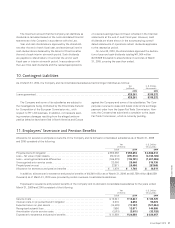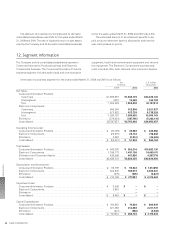Sharp 2010 Annual Report Download - page 50
Download and view the complete annual report
Please find page 50 of the 2010 Sharp annual report below. You can navigate through the pages in the report by either clicking on the pages listed below, or by using the keyword search tool below to find specific information within the annual report.
If the fair market value of other securities declines signifi-
cantly, such securities are stated at fair market value and the
difference between the fair market value and the carrying
amount is recognized as loss in the period of decline. If the
net asset value of other securities with no available fair
market values declines significantly, the securities are written
down to the net asset value and charged to income. In these
cases, the fair market value or the net asset value is carried
forward to the next year.
(f) Inventories
Inventories held by the Company and its domestic consoli-
dated subsidiaries are primarily stated at moving average
cost (for balance sheet valuation, in the event that an impair-
ment is determined inventories impairment is computed
using net realizable value). For overseas consolidated subsid-
iaries, inventories are stated at the lower of moving average
cost or market.
(g) Depreciation and amortization
For the Company and its domestic consolidated subsidiaries,
depreciation of plant and equipment, other than lease assets
is computed using the declining-balance method, except for
machinery and equipment at the LCD plants in Mie,
Kameyama and Sakai, as well as buildings (excluding attached
structures) acquired by the Company and its domestic consoli-
dated subsidiaries on and after April 1, 1998; All of which are
depreciated using the straight-line method over the estimated
useful life of the asset. Properties at overseas consolidated
subsidiaries are depreciated using the straight-line method.
Maintenance and repairs, including minor renewals and
betterments, are charged to income as incurred.
Amortization of intangible assets except for lease assets
is computed using the straight-line method.
Depreciation of lease assets under finance leases that do
not transfer ownership is computed using the straight-line
method, using the lease period as the depreciable life and the
residual value as zero. Finance leases of the Company and its
domestic consolidated subsidiaries that do not transfer own-
ership, for which the starting date of the lease transaction is
on and before March 31, 2008, lease payments are recog-
nized as expenses.
(h) Accrued bonuses
The Company and its domestic consolidated subsidiaries
accrue estimated amounts of employees’ bonuses based on
the estimated amounts to be paid in the subsequent period.
(i) Income taxes
The asset and liability approach is used to recognize deferred
tax assets and liabilities for the expected future tax conse-
quences of temporary differences between the carrying
amounts of assets and liabilities for financial reporting pur-
poses and the amounts used for income tax purposes.
(j) Severance and pension benefits
The Company and its domestic consolidated subsidiaries
have primarily a trustee noncontributory defined benefit pen-
sion plan for their employees to supplement a governmental
welfare pension plan.
Certain overseas consolidated subsidiaries primarily have
defined contribution pension plans and lump-sum retirement
benefit plans.
The Company and its domestic consolidated subsidiaries
provide an allowance for severance and pension benefits
based on the estimated amounts of projected benefit obliga-
tion and the fair value of plan assets at the balance sheet
date. Projected benefit obligation and expenses for severance
and pension benefits are determined based on the amounts
actuarially calculated using certain assumptions.
Prior service costs are amortized using the straight-line
method over the average of the estimated remaining service
years (16 years) commencing with the current period. Actu-
arial gains and losses are primarily amortized using the
straight-line method over the average of the estimated
remaining service years (16 years) commencing with the
following period.
(k) Research and development expenses and
software costs
Research and development expenses are charged to income
as incurred. The research and development expenses are
charged to income amounted to ¥195,525 million and
¥166,507 million ($1,809,859 thousand) for the years ended
March 31, 2009 and 2010, respectively.
Software costs are recorded principally in other assets.
Software used by the Company is amortized using the
straight-line method over the estimated useful life of princi-
pally 5 years, and software embedded in products is amor-
tized over the forecasted sales quantity.
(l) Derivative financial instruments
The Company and some of its consolidated subsidiaries use
derivative financial instruments, including foreign exchange
forward contracts and interest rate swap agreements, in order
to hedge the risk of fluctuations in foreign currency exchange
rates and interest rates associated with assets and liabilities
denominated in foreign currencies and debt obligations.
All derivative financial instruments are stated at fair value
and recorded on the balance sheets. The deferred method is
used for recognizing gains or losses on hedging instruments
and the hedged items. When foreign exchange forward con-
tracts meet certain conditions, the hedged items are stated
by the forward exchange contract rates.
Financial Section
SHARP CORPORATION48



